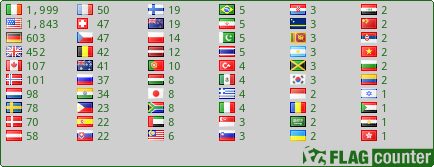Parking is available halfway along the Vico Road (waypoint provided). There are several paths from here that all lead down over the railway line and down the steep steps onto Whiterock beach. I have provided waypoints for these paths near the parking area. Here you will see close up, the dramatic contact between two contrasting rock types at Whiterock, but first, a little information about rocks.
Rocks
The scientific study of rocks is called petrology.
Rocks are named according to the way in which they were formed. There are 3 types:
- Igneous
- Sedimentary
- Metamorphic
Igneous (from the Latin "ignis" - fire)
Igneous rocks originates from molten matter deep inside the earth. Hot magma (liquid rock) comes up through cracks in the earth’s surface and fills other cracks or forms a layer on the surface. It then cools forming a very hard igneous rock.
Sedimentary (from the latin word meaning to settle)
Sedimentary rock is formed from broken bits and pieces of different rocks. The three most common forms of sedimentary rock are limestone, sandstone and shale. Sedimentary rocks are very important as three quarters of the mass of the continents are covered with a thin layer of them, and concentrated within them are important resources such as coal, oil, groundwater and iron ore.
Metamorphic (from two greek words meaning change and form)
Metamorphic rocks formed from igneous or sedimentary rocks that have been changed into a new rock. They form as a result of high pressures or temperatures. Sandstone gets changed into quartzite and limestone gets changed into marble. These new rocks are not as hard as igneous rock but can be very heavy. Slate, schist, gneiss and quartzite are other examples.
The three rock types are transformed into one another by processes of weathering and erosion, melting and exposure to heat and pressure.
Rocks at Whiterock
Killiney Hill is composed of an igneous rock called granite, which cooled from a molten magma forced up into the surrounding shales during the Devonian geological period (around 400 million years ago). Where the granite heated the adjacent shales, a new type of (metamorphic) rock called schist was formed. Both granite and schist have proved quite resistant to erosional forces over time.
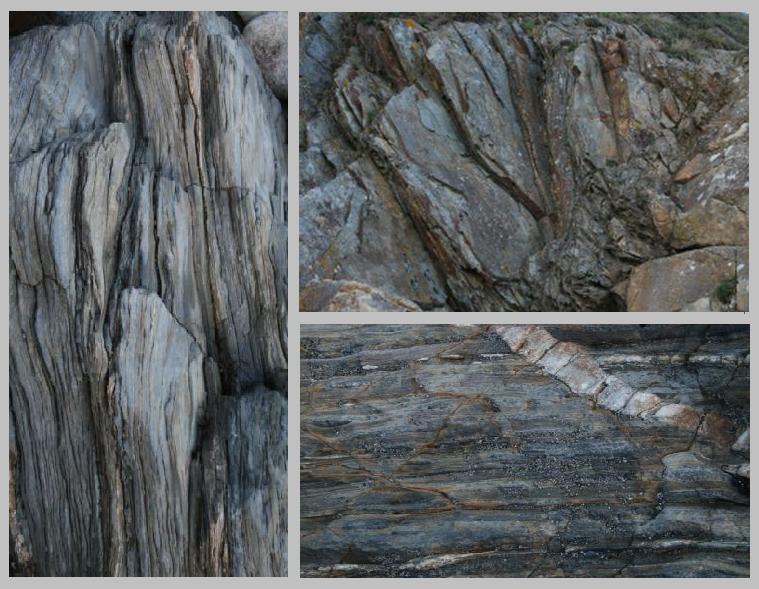
At Whiterock you can see close-up, an outcrop of rocks which shows the contact between the granite of Killiney Hill & the adjacent Ordovician mica-schists. The Ordovician period of geological time is about 475 million years ago. Here you are seeing the original relationship between the rocks from the time of the granite intrusion. The rocks against which the granite abuts are called mica-schists, characterised by thin, parallel bedding planes along which the rock tends to split. Extreme heat from the granite intrusion metamorphosed what were originally compacted sandstones & mudstones from the Iapetus sea floor, into schists. (Iapetus was a deep ancient ocean of the Ordovician period.) Shiny plate-like crystals of mica are orientated along the bedding planes as a result of pressure from the granite. New minerals such as garnet and andalusite also formed in the zone of metamorphism (the area where the two rocks contact each other). The andalusite can be picked out as a dark criss-cross pattern of crystals covering the bedding planes of the mica-schists.
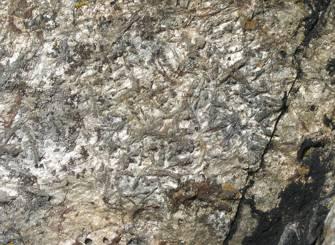
Andalusite crystals on a mica-schist bedding plane
When viewed closely, the granite can be seen to be composed of three main minerals which occur as grains a few millimetres across; glassy grey quartz, white feldspar and shiny plate-like micas, which impart the glint to the rock. The granite was worked from a quarry on the Dalkey side of the hill for the construction of the Dun Laoghaire harbour piers between 1817 and 1859. Six million tonnes of granite were transported along a straight narrow-gauge tramway, the line of which still exists in places as the 'Metals' pathway.
Pebbles on the beach
Most of the pebbles have come from the glacial cliffs behind killiney beach, having been plucked as fragments from various rock formations near and far, and carried by ice age glaciers as they scoured the landscape. The fragments have been rounded and smoothed from the wave action of the sea. They represent a stage in the ongoing tectonic rock cycle of igneous intrusion, mountain building, erosion, sedimentation of the detritus, compaction, deformation and metamorphism.
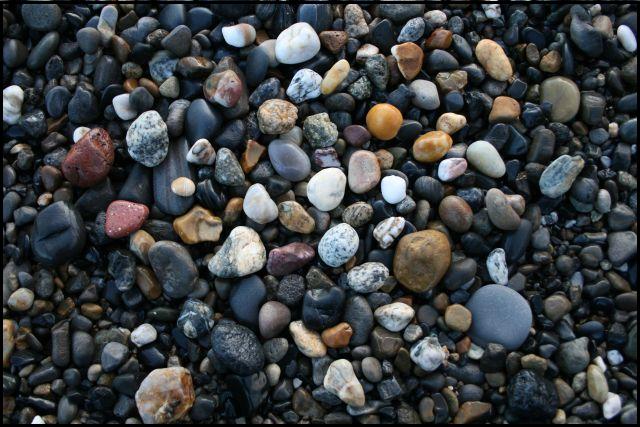
Looking at these pebbles is a good way of seeing a variety of rocks, minerals and fossils that make up the three rock groups known as sedimentary, igneous and metamorphic. Take a look for yourself and see what you can find.There is an abundance of beautiful coloured pebbles to find on the beach. We took these photos of the pebbles that we found during one of our trips there.
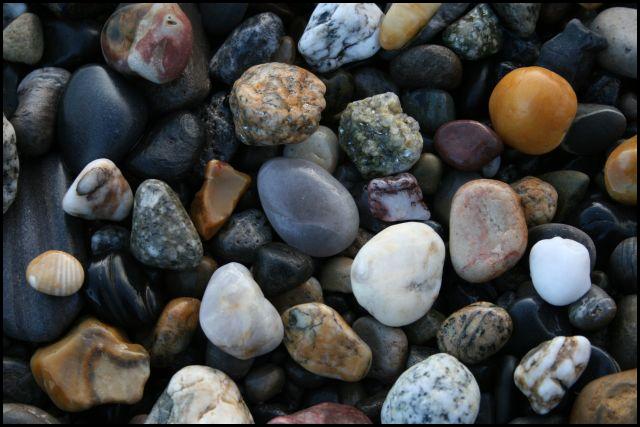
The Abandoned Mine
The contact between intruded granites and their surrounding 'country' rocks is significant in that this is also the site of economically important mineralisation. A short distance northwards from the granite-schist contact, there is an old mine entrance in the cliff (it is unsafe to enter),that can be seen when the tide is out, where lead and copper was worked sporadically during the 1750's and 1820's.
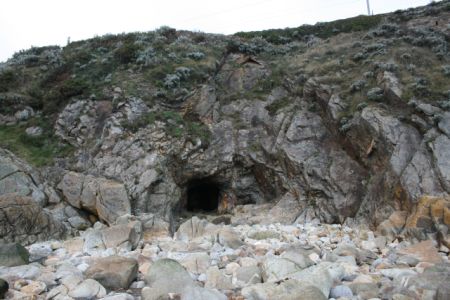
Note : Close inspection of the rocky part of the beach is tidal dependent. You can check the tides HERE It isn't necessary to time your visit for the exact time of low tide, just be aware of when the tide is coming in and going out. Remember safety first! : )
To log your visit
Please email us through our profile (Email, not the message centre, thanks) the answers to the following :-
1.Describe and compare the colour, texture and appearance between the schists and the granite.
2.Look for and measure the andalusite. Please take a photograph of your find.
3. With your back to the sea, how many man made stone arches do you see?
The following is optional and NOT a requirement to log your visit - Feel free to upload any photos you take during your visit to the earthcache site providing they don't give away the answers to the logging requirements.
Do not wait to log your find. As soon as you have emailed the answers via our profile, please log the cache as found. Note: You will be contacted if no answers are received or if there are any issues with your answers.
 HAPPY EARTHCACHING!
HAPPY EARTHCACHING!
| I am a proud |
 |
